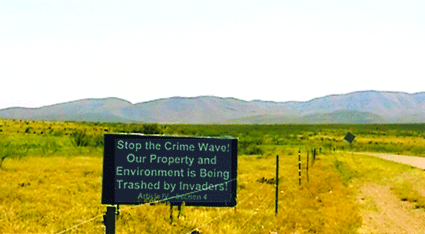Anthology salute to queer Belgian master spotlights unsung docs
Is Chantal Akerman the greatest woman director in the history of film? Just ahead of a December 3 symposium at Princeton devoted to the Belgian Jewish lesbian auteur, Anthology Film Archives is hosting a capsule retrospective through this weekend, including two of her superb, undervalued documentaries, “South” and “From the Other Side.”
The question of Akerman’s preeminence has been gnawing at me since last fall, when I was confronted by it in the catalogue for Cinematexas, Austin’s annual experimental summit. Hold on, I said. Could it be that Akerman, who seems always to have been there, dependably debuting film after film across my lifetime of moviegoing, is actually the ne plus ultra?
Reflexively I thought, no way. In continental Europe alone, competing claims could be argued for Agnès Varda, Kira Muratova, Ulrike Ottinger, and the ever more visionary Claire Denis, to say nothing of, well, the rest of the world. Surely there’s plenty of greatness going around—must we choose among them?
Then Akerman’s latest feature “Tomorrow We Move” appeared, albeit straight to DVD. Though not among her very finest, it flaunts all her singular virtues, and after being brought to tears by its understated evocation of Holocaust memory, a suspicion dawned: Were those wily Texans right? Has Akerman not gotten her proper due?
Born in 1950 to Ashkenazi Polish émigrés in Brussels, Akerman’s diminutive frame is in directly inverse proportion to her artistic prowess, intellectual heft, and copious output. As a wayward 21-year-old, she landed in New York and was decisively exposed to the structuralist movement then ascendant in the avant-garde. This encounter permanently instilled her filmmaking with an often-imposing formal rigor, leavened in her best work by a droll wit, latent or explicit musicality, and an atmosphere of erotic immanence.
In 1975 Akerman vaulted to fame with “Jeanne Dielman, 23 quai du Commerce, 1080 Bruxelles,” a three-and-a-half hour portrait of a widowed, middle-aged mother who turns tricks while her boy’s at school, long hailed as the apogee of 1970s cinematic feminism. Its precisely choreographed minimalism, approximation of real time, and shocker dénouement continue to provoke, even polarize, audiences to this day. Yet the unity of Akerman’s conception, Babette Mangolte’s toasty cinematography, and the late Delphine Seyrig in the title role make “Jeanne Dielman” a thing of imperishable beauty.
Across some 40 works to date—comprising theatrical feature films, portmanteau segments, TV commissions, media installations, and published fiction—the peripatetic queer icon has carved a unique trajectory between experimentalism and the commercial art cinema, while switching between, and productively confusing, fiction and nonfiction.
Forming a loose triptych on borders—historical, national, and racial, among others—her documentaries “From the East” (1993), “South” (1999), and “From the Other Side” (2002) respectively examine post-Communist Eastern Europe, a lynching in East Texas, and the combustible U.S.-Mexican frontier. While the much-analyzed “From the East” looks more like a masterpiece with every screening, the less familiar “South” and “From the Other Side,” screening this weekend, deserve closer attention.
One of Akerman’s most accessible documentaries, “From the Other Side,” screening November 27, was made a few years ago but its depiction of la frontera could hardly be timelier. Its grim currency derives not least from the fact that a record number of labor migrants have died so far this year trying to cross the heavily militarized border, a 40 percent increase over 2004. The majority of them died in pain and terror, felled by the extremities of the Sonora desert crossing—dehydration, vipers, shearing winds—if not at the hands of the human traffickers known as “coyotes,” or of the armed U.S. nativist vigilantes.
Bear this in mind as you listen to the 21-year-old Francisco Santillán Garcia, the first of several Mexican speakers in “From the Other Side,” describe in its opening minutes how one unfortunate migrant band succumbed to the merciless desert heat. Akerman’s signature long takes—enabling us to move “from the concrete to the abstract and come back to the concrete,” as she told Artforum—of arid streets in Agua Prieta and the barrier fence punctuate interviews with the elderly parents of two sons lost in a failed crossing. Their heart-scraping testimony contrasts with the cherubic 14-year-old Rafael Gonzales, outwardly cavalier but inwardly fearful in his clipped replies to Akerman’s questions, audible throughout the film in her gawky, accented Spanish.
After the hour-mark, the film jumps the border, as it were, and shifts focus to denizens of the U.S. One of its practical virtues is to show us, again, the face of white racism, embodied here by a U.S. border guard who invokes their “daily war” while eulogizing at another officer’s funeral, and by the couple identified in the credits rather too delicately as “Mme. et M. Wes Flowers,” a pair of unhinged, trigger-happy homesteaders.
Madame Flowers equates migrants with the 9/11 hijackers, while the affable Wes describes Mexicans as smallpox vectors. Evidently it took little coaxing for him to aver, “If they came at me, I wouldn’t hesitate to use a gun.” During the interview with the Flowerses, Akerman lays Chopin’s “Valse No. 3” softly into the soundtrack, a counterpoint that mocks their “civilized” veneer, but also suggests the immediacy this material must have for her as a European—witness the recent French immigrant paroxysm.
So is she the greatest? The question is unanswerable, of course. But her recognition—the Princeton seminar, last year’s Pompidou Center exhibition, tributes at festivals worldwide—is beginning to catch up with the scope of her genius.
gaycitynews.com


































